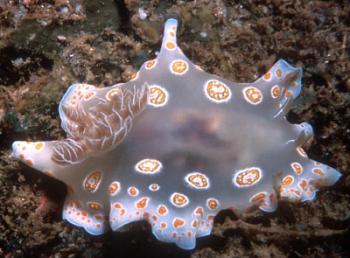
Chromodoris marislae
Bertsch, 1973
Order: NUDIBRANCHIA
Suborder: DORIDINA
Superfamily: EUDORIDOIDEA
Family: Chromodorididae
DISTRIBUTION
Central and southern Gulf of California
PHOTO
8 meters at San Carlos on the Mexican mainland side of the Sea of Cortez. 50mm long. Photo: Scott Johnson
Off-white body with 2 or 3 irregular rows of orange spots along the edge of the notum. Spots increasing in size and irregularity from outer to inner row. An additional row of orange circles/ovals is present just anterior to the rhinophores along the body just lateral to the mid dorsal region, each orange marking being banded by a conspicuous white line. Mantle covered in low, closely spaced tubercles. Distal portion of the rhinophores a light brown with a prominent medium white longitudinal septum on both anterior and posterior faces. See my discussion below about whether this could be a species of Tyrinna.
[Nomenclatural Note: The publication cited below in which this species is described has multiple authors but the description of this species is entitled 'Chromodoris marislae, Bertsch, spec. nov.' indicating that Bertsch is the sole author of the name. A full citing of the name would be 'Chromodoris marislae Bertsch in Bertsch, Ferreira, Farmer & Hayes, 1973.]
Reference:
• Bertsch, H., Ferreira, A.J., Farmer, W.M. & Hayes, T.L. (1973) The genera Chromodoris and Felimida (Nudibranchia: Chromodorididae) in tropical west America: distributional data, description of a new species, and scanning electron microscopic studies of radulae. The Veliger, 15(4): 287-294.
• Bertsch, H. (1978). The Chromodoridinae Nudibranchs from the Pacific Coast of America – Part II. The genus Chromodoris. The Veliger, 20 (4): 307-327.
Rudman, W.B., 2000 (October 14) Chromodoris marislae Bertsch, 1973. [In] Sea Slug Forum. Australian Museum, Sydney. Available from http://www.seaslugforum.net/find/chromari
Related messages
Chromodoris marislae from Puerto Vallarata, Mexico
December 2, 2009
From: Kevin Lee
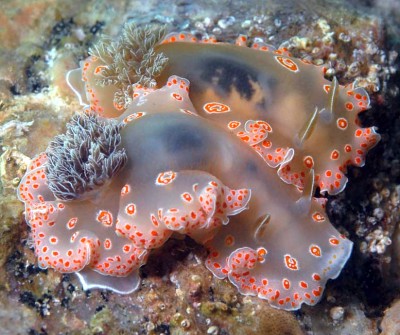
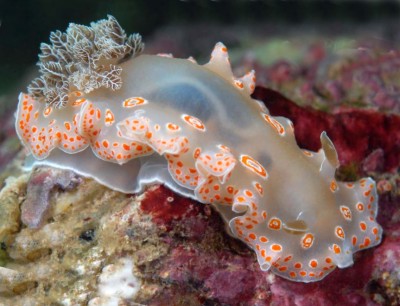
Dear bill,
Here is Chromodoris marislae, one of the few slugs I found myself. These striking beauties were under a rock.
Locality: Majahuitas, Puerto Vallarata, 30fsw, Mexico, East Pacific, 06 July 2009, Rocky reef. Length: 1.5 inches. Photographer: Kevin Lee.
K;-)
diverkevin@gmail.com
Lee, K., 2009 (Dec 2) Chromodoris marislae from Puerto Vallarata, Mexico. [Message in] Sea Slug Forum. Australian Museum, Sydney. Available from http://www.seaslugforum.net/find/22904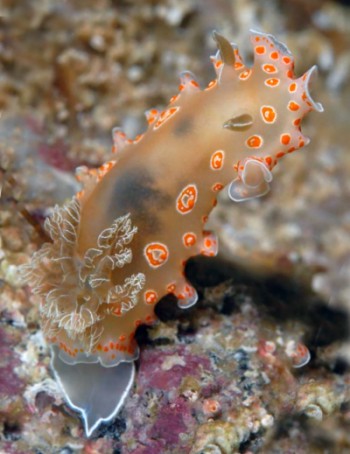
Dear Kevin,
As I have discussed earlier [#6748], the relationships of this beautiful species could be quite interesting. In particular it would be nice to know what sponge or sponges it feeds on. I wondered if perhaps it was more related to Tyrinna than Chromodoris and since Tyrinna nobilis seems to prefer dysideid sponges while species of Chromodoris prefer darwinellid sponges, knowing what C. marislae fed on might give us a useful clue.
Best wishes,
Bill Rudman
Chromodoris marislae from Sea of Cortez
August 15, 2007
From: Marco Villegas M.
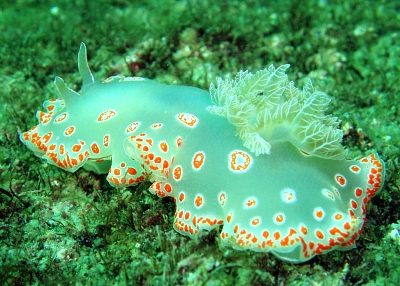
I found this nudibranch at the Espiritu Santo Island, La Paz, Mexico and I cant´t find it on the web
Locality: Espiritu Santo Island, 8 mts 24 ft, La Paz, Mexico, Sea of Cortez, 26 june 07, rocky bottom. Length: 8.5 cm. Photographer: Marco Villegas M..
Marco Villegas
pasto67@hotmail.com
Villegas, M., 2007 (Aug 15) Chromodoris marislae from Sea of Cortez. [Message in] Sea Slug Forum. Australian Museum, Sydney. Available from http://www.seaslugforum.net/find/20456Dear Marco,
This is Chromodoris marislae. As you will see for earlier messages on the Forum I suspect this species may not be a Chromodoris, as the arrangement of the glands in its mantle (under the orange patches) are rather different. Someone needs to re-examine its anatomy.
Best wishes,
Bill Rudman
Chromodoris marislae from deep water
April 24, 2002
From: Alicia Hermosillo
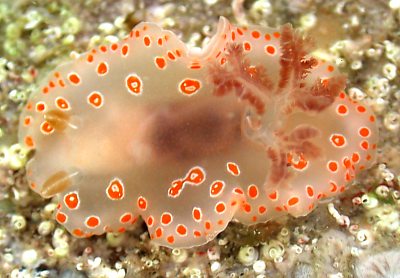
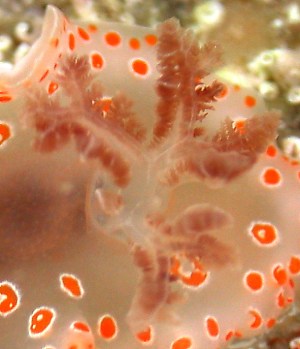
Hello Dr. Rudman!!
This is a photo of the first specimen of Chromodoris marislae I found in Bahia de Banderas. In March I went deep diving because I had to practice some skills... any ways, I came across this specimen at 187 feet of depth, in Los Arcos, Bahia de Banderas. It was within a little crevice. The water temperature at depth was 67oF.
As far as I know this is a pretty big range extension (south and deep wise). I think it will be interesting to see if I find more specimens of this species and the depths at which they are living in Bahia de Banderas.
Ali
alicia_titan@infosel.net.mx
Hermosillo, A., 2002 (Apr 24) Chromodoris marislae from deep water. [Message in] Sea Slug Forum. Australian Museum, Sydney. Available from http://www.seaslugforum.net/find/6798Thanks Ali,
This photo shows the very bushy gills of this species, quite unlike other species of Chromodoris.
Best wishes,
Bill Rudman
Chromodoris marislae from Mexico
April 18, 2002
From: Alicia Hermosillo
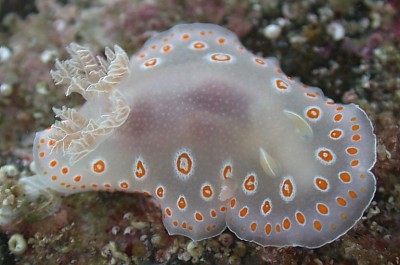
Dear Dr. Rudman,
Last Saturday I went diving to the Islas Marietas, North tip of Bahia de Banderas, Pacific Coast of Mexico, and found this specimen of Chromodoris marislae, and three more, at 33 feet deep.
By chance a week ago I had asked myself if this species was perhaps confined to deeper water in Bahia de Banderas as the only one I had seen previously was from 187 feet. So it only took me a week to answer my question!
Alicia Hermosillo
alicia_titan@infosel.net.mx
Hermosillo, A., 2002 (Apr 18) Chromodoris marislae from Mexico. [Message in] Sea Slug Forum. Australian Museum, Sydney. Available from http://www.seaslugforum.net/find/6748Dear Ali,
I hope all your questions can be answered so quickly. By the way have you come across any other orange spotted species yet? This animal looks quite similar to Tyrinna evelinae which is reported from the eastern Pacific, so I wondered perhaps if you have an orange-spotted colour group there.
The second point worth considering is whether this is really a Chromodoris at all? I wouldn't be at all surprised if this species was actually a species of Tyrinna. Your photo suggests the inner row of large orange spots may be a series of large mantle glands [MDFs] and the smaller outer spots could easily hide smaller glands beneath. The secondary branching on the gills is also quite unlike a species of Chromodoris. The only information I can find on the anatomy of this species are the radular descriptions in Bertsch, et al (1973) and Bertsch (1978). The radula formula is consistent with both genera, and the presence of a central [rachidian] tooth which sometimes has a bifid cusp is certainly unusual for Chromodoris. Clearly the reproductive system needs to be examined and the radula re-examined. It is interesting to compare C. marislae with the comprehensive redescription of Tyrinna nobilis by Munia et al (1996). That species is very similar in colour and shape and found on both coasts of southern South America.
• Munia, C., Valdes, A. & Ortea, J. (1996) Redescription of Tyrinna nobilis Bergh, 1898 (Opisthobranchia: Chromodorididae) from Patagonia, Argentina. Journal of Molluscan Studies, 62: 265-273.
Best wishes,
Bill Rudman
Chromodoris marislae from the Eastern Pacific
October 15, 2000
From: Scott Johnson

Hi Bill,
Here's another of the large and distinctive Eastern Pacific chromodorids. This one is Chromodoris marislae. It measured about 50mm in length and was photographed at about 8 meters at San Carlos on the Mexican mainland side of the Sea of Cortez.
Scott
johnson@kmr.ll.mit.edu
Johnson, S., 2000 (Oct 15) Chromodoris marislae from the Eastern Pacific. [Message in] Sea Slug Forum. Australian Museum, Sydney. Available from http://www.seaslugforum.net/find/3170Thanks Scott,
Bill Rudman.
